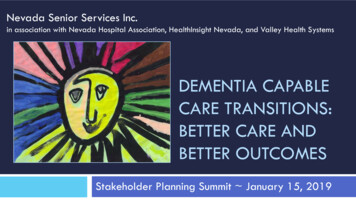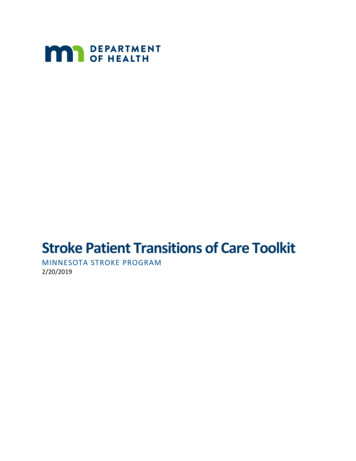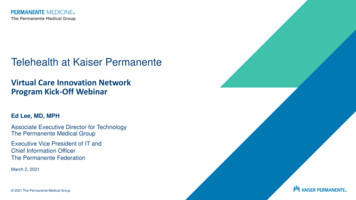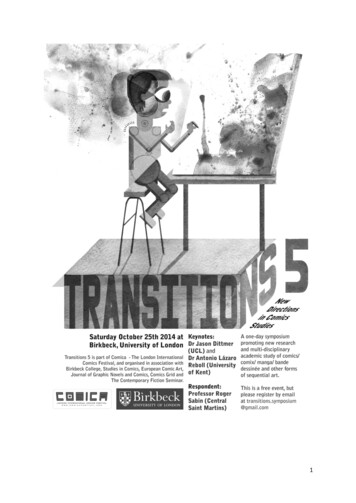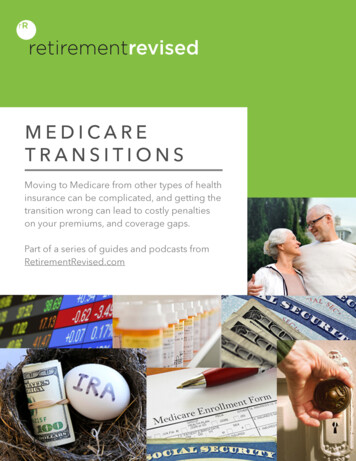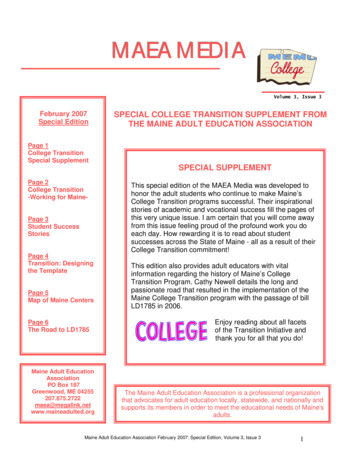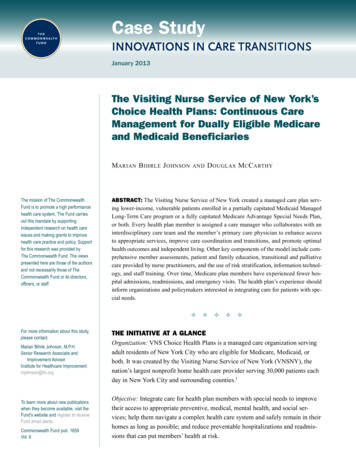
Transcription
Case StudyINNOVATIONS IN CARE TRANSITIONSJanuary 2013The Visiting Nurse Service of New York’sChoice Health Plans: Continuous CareManagement for Dually Eligible Medicareand Medicaid BeneficiariesM arian B ihrle J ohnsonThe mission of The CommonwealthFund is to promote a high performancehealth care system. The Fund carriesout this mandate by supportingindependent research on health careissues and making grants to improvehealth care practice and policy. Supportfor this research was provided byThe Commonwealth Fund. The viewspresented here are those of the authorsand not necessarily those of TheCommonwealth Fund or its directors,officers, or staff.andABSTRACT: The Visiting Nurse Service of New York created a managed care plan serving lower-income, vulnerable patients enrolled in a partially capitated Medicaid ManagedLong-Term Care program or a fully capitated Medicare Advantage Special Needs Plan,or both. Every health plan member is assigned a care manager who collaborates with aninterdisciplinary care team and the member’s primary care physician to enhance accessto appropriate services, improve care coordination and transitions, and promote optimalhealth outcomes and independent living. Other key components of the model include comprehensive member assessments, patient and family education, transitional and palliativecare provided by nurse practitioners, and the use of risk stratification, information technology, and staff training. Over time, Medicare plan members have experienced fewer hospital admissions, readmissions, and emergency visits. The health plan’s experience shouldinform organizations and policymakers interested in integrating care for patients with special needs. For more information about this study,please contact:Marian Bihrle Johnson, M.P.H.Senior Research Associate andImprovement AdvisorInstitute for Healthcare Improvementmjohnson@ihi.orgTo learn more about new publicationswhen they become available, visit theFund's website and register to receiveFund email alerts.Commonwealth Fund pub. 1659Vol. 6D ouglas M c C arthy THE INITIATIVE AT A GLANCEOrganization: VNS Choice Health Plans is a managed care organization servingadult residents of New York City who are eligible for Medicare, Medicaid, orboth. It was created by the Visiting Nurse Service of New York (VNSNY), thenation’s largest nonprofit home health care provider serving 30,000 patients eachday in New York City and surrounding counties.1Objective: Integrate care for health plan members with special needs to improvetheir access to appropriate preventive, medical, mental health, and social services; help them navigate a complex health care system and safely remain in theirhomes as long as possible; and reduce preventable hospitalizations and readmissions that can put members’ health at risk.
2 T he C ommonwealth F undTarget Population: Approximately 20,000 vulnerableand ethnically diverse VNS Choice members enrolledin a Medicaid Managed Long-Term Care (MLTC)program or a Medicare Advantage Special Needs Planor both (Exhibit 1). Most members are elderly, sufferfrom multiple chronic conditions, and speak a language other than English.Team: A specially trained care manager—typicallya nurse—is assigned to each member to coordinateservices from an interdisciplinary team, which mayinclude physicians, nurses, home health aides, rehabilitation therapists, nutritionists, social workers, behavioral health specialists, transitional care and palliativecare nurse practitioners, clinical pharmacists, memberservices representatives, family caregivers, and community service providers.Approach: Integrate care across settings with customized interventions, which include:1. Comprehensive assessment of members, oftenconducted in their homes.2. Continuous care management to meet members’ medical, psychosocial, cognitive, andfunctional needs, with an emphasis on in-person member encounters, including home visits,and collaborative relationships with hospitalsand primary care physicians.3. Teaching and coaching for members and family caregivers about how to monitor and optimally manage health conditions.4. Risk stratification—largely driven by patternsof prior hospitalization—to identify and intensify care management for members at highestrisk for rehospitalization.5. Interdisciplinary team meetings to review thecare needs and plans of high-risk members,such as those admitted to a hospital or skillednursing facility.Exhibit 1. VNS Choice Health Plans for Dually Eligible Medicare and Medicaid BeneficiariesMedicaid Managed Long-Term Care(MLTC)Medicare Advantage Special Needs Plan(SNP) and Part DEnrollment(December 2012)16,351 members7,194 membersBenefits andservices providedAlternative to long-term institutional care:covers 14 home and community-basedservices including care management, homehealth care, nursing home, adult day care,home-delivered mealsCovers all Medicare services for Part A(inpatient), Part B (outpatient), and Part D(prescription drugs). Supplemental benefits:dental, vision, hearing, transportationPayment sourceNew York State Medicaid, partially capitated,rates risk-adjusted by population (two-yearpayment lag)Federal Medicare program, fully capitated,rates risk-adjusted by individualProviders1,900 network providers29 nursing homes2,200 primary care physicians, 5,800 specialists, 37 hospitals, 32 nursing homes,labs, pharmacies600 60 Staff100 staff support a shared health plan infrastructureApproximately 2,500 VNS Choice members are jointly enrolled inboth the Medicaid MLTC plan and the Medicare Advantage SNPSources: Adapted from Visiting Nurse Service of New York; New York State Medicaid and CMS Medicare Advantage enrollment reports.
T he V isiting N urse S erviceofN ew Y ork ’ s C hoice H ealth P lans6. Transitional care by a nurse practitioner following a hospital stay.7. Palliative care for members with life-limitingchronic disease.8. Information technology to facilitate decisionmaking, communication, and monitoring.9. Frequent staff training on protocols and skills,such as how to identify potentially preventablereasons for hospital admission and modify careplans to reduce the risk of readmission.Timeline: VNS Choice began enrolling MLTC members in 1998 under a New York State Medicaid demonstration program subsequently authorized by statelegislation. Its Medicare Advantage Special Needs Planwas licensed in 2006 and began enrolling members in2007.Results in Brief: A cohort of 573 continuously enrolledMedicare health plan members experienced a 54 percent decrease in hospital admissions, a 24 percentdecrease in hospital readmissions within 30 days,and a 27 percent decrease in emergency visits over24 months. Among all dually eligible Medicare andMedicaid Choice members, there was a 21 percentrelative reduction in the trend for the 30-day all-causereadmission rate between the first six months of 2009and the first six months of 2011.THE CHALLENGEAlmost 9 million low-income elderly or disabledadults are dually eligible for Medicare and Medicaidin the United States.2 Many of these individuals arein poor health and have complex acute and long-termcare needs that account for a disproportionate share ofMedicare and Medicaid spending.3 Lack of incentivesfor care coordination under separate federal and statefee-for-service payment systems often leads to fragmented and unnecessary services as well as suboptimalpatient and family experiences typified by relativelyhigh rates of preventable hospitalizations.4,5 Povertycoupled with inadequate housing or social supports can3complicate efforts to help individuals maintain theirhealth or recover after a hospital stay.The federal government and many states areinterested in improving the coordination of care fordually eligible beneficiaries through alternative payment and delivery models. Among these are federallyregulated Medicare Advantage Special Needs Plansand state-regulated Medicaid Managed Long-TermCare Plans that contract to deliver a range of coveredbenefits in exchange for a fixed payment per beneficiary.6 Participating health plans must develop specialexpertise to effectively meet the diverse needs ofdually eligible individuals who enroll in such plans.This case study describes how a large nonprofit homehealth care provider created health plans to serve thispopulation and, in particular, how its customized caremanagement approach has led to reductions in hospitalizations and readmissions.THE IMPETUS FOR CHANGEIn 1994, The Commonwealth Fund made a planninggrant to the State of New York to design a new payment model for integrated home, community, andfacility-based long-term care.7 The resulting MedicaidManaged Long-Term Care (MLTC) program paysparticipating health plans a fixed amount per enrollee(known as “partial capitation”) to provide a bundle ofcomprehensive long-term care and related services andto coordinate enrollees’ care across all settings (Exhibit1).8 MLTC serves Medicaid-eligible adults with functional impairments who qualify for long-term careservices and who are able and wish to continue livingsafely at home with supportive services.9 The goal ofMLTC is to promote health and independent living inthe community to avoid or delay the need for long-terminstitutional care.As an experienced home health care provider,VNSNY’s leaders viewed participation in the MLTCprogram as an opportunity to fulfill the organization’s nonprofit mission by better meeting the needs ofmedically frail elderly patients with limited incomes.VNSNY created a health plan that was one of fiveselected to participate in New York’s initial MLTC
4 T he C ommonwealth F unddemonstration. The VNS Choice MLTC plan enrolledits first members in January 1998 and has sincebecome the largest and fastest growing MLTC plan inthe state.10 The plan serves a culturally diverse population of members. The average MLTC member is 82years old and has four chronic illnesses and multiplefunctional deficits; over half suffer moderate to severecognitive impairment; three of five speak a languageother than English.The MLTC program covers 14 home and community-based services. Hospital and physician care arenot covered but are typically paid for by Medicare—or by a Medicare Advantage plan, if the member isenrolled in one. The MLTC plan’s responsibility tocoordinate care across all settings creates an indirectincentive to reduce unnecessary hospital use andreadmissions. “The burden placed on the elderly fromadmissions and readmissions are stressful events whichtend to move individuals closer to the point of suchdisability and risk that long-term institutional care maybe needed for their own safety,” says Carol Raphael,VNSNY’s former CEO. Reducing hospitalizations supports the aim of MLTC to forestall the use of long-termcare facilities, for which the MLTC plan is financiallyresponsible. In essence, total care management acts asa mechanism to integrate care as fully as possible eventhough payment is only partially integrated.11In 2006, VNSNY built on its experience withMLTC to create a Medicare Advantage Special NeedsPlan regulated by the federal government. The SpecialNeeds Plan is offered to low-income adults who aredually eligible for Medicare and Medicaid; enrollmentin such plans is voluntary under federal law.12 Based onconsumer interest, VNS Choice also created MedicareAdvantage plan options for Medicare beneficiarieswho are not eligible for Medicaid, although enrolleestend to have lower incomes. Because the MedicareAdvantage plans are financially at risk for providingMedicare-covered benefits including inpatient and outpatient care under a capitation arrangement, they havea direct incentive to reduce unnecessary hospital use.A subset of approximately 2,500 VNS Choice members have jointly enrolled in both the Choice MedicareAdvantage Special Needs Plan and the ChoiceMedicaid MLTC plan, or in a Medicaid Advantage Plusplan that combines both programs, which offers theopportunity to fully integrate services across the entirecare continuum including both acute and long-termcare (Exhibit 1).THE STEPS OF CHANGEBuilding the InfrastructureTo create an infrastructure for its Choice plans,VNSNY developed expertise to manage the financialrisk associated with capitation. This involved: building a provider network that includedprimary care physicians with geriatric competency, specialists, hospitals, laboratories, pharmacies, and transportation services; training nurse care managers and other staff fornew roles; engaging in individual marketing to prospective members; establishing membership services including acall center; and investing in information technology, such aselectronic health records.Medicare Advantage plan members receivecovered benefits from providers who participate in thehealth plan’s contracted network. Although MedicaidMLTC members are not required to select or use anetwork physician, they must have a primary doctorwho is willing to coordinate care with VNS Choice.Establishing Continuous CareManagementEach Choice health plan member is assigned a specially trained care manager—typically a nurse—whoestablishes a continuous care management relationshipwith the member and his or her family caregivers andwho coordinates care with the member’s physician andother care providers. This role includes conductingperiodic assessments, preparing and overseeing a care
T he V isiting N urse S erviceofN ew Y ork ’ s C hoice H ealth P lansplan, teaching and coaching members and family caregivers to self-manage chronic conditions, and overseeing transitional care for members at vulnerable handoff points in the care continuum (Exhibit 2). Membersalso may call to speak with a nurse about health concerns 24 hours a day.Among Choice members enrolled in theMedicaid MLTC plan, care managers—called nurseconsultants—coordinate the continuum of care with thesupport of an interdisciplinary team that may includehome health aides, nurse practitioners, psychiatricnurses, social workers, rehabilitation consultants, nutritionists, and medical directors. Any member of thecare team may call a case conference when needed toreview the care needs of a particular member. Ongoingroutine check-ins with the care team generally coverfour questions:51. What’s going well for the patient?2. What’s not going well for the patient?3. What can be done to address problems?4. What are the next steps?Nurse consultants handle an average caseloadof 38 to 43 MLTC members, whom they visit at homeand contact by telephone as needed. Patients with moreintensive needs receive more frequent contacts. A largepart of the job involves supervising home health aides,who are contracted through a subsidiary licensed homehealth care services agency. Home health aides carryout the care plan in the member’s home and provideupdates on the member’s condition to help identifyissues for attention, such as the need for home-safetymodifications to prevent falls.13 For members receivinglong-term custodial care in a nursing home, the MLTCExhibit 2. VNS Choice: Continuous Care Management Before and After HospitalizationPre-HospitalizationUtilization dataRelationship with community membersRelationship with providersCare manager works closelywith the member, his or her family,and his or her physician to: Develop a plan of care Visit in the home to provide care andmonitor health Coordinate all health care services,long-term care, and health-relatedservices—home, community, andfacility-based servicesRisk assessmentCare manager and NP alerted when patientis admittedGather information about the hospitalizationVNS ChoiceBegin care coordination process during thehospitalizationIn-home visit within24 hours of dischargeNP accompanies member to firstfollow-up physician visitOngoingNP coordinates all care with PCP and othercare providers for 30-day transitional periodNPs trained in Naylor and Colemancoaching modelsWarm handoff at the end of the 30-dayperiodNotes: NP nurse practitioner; PCP primary care physician.Source: Authors.30 Days Post-HospitalizationDuringHospitalization
6 T he C ommonwealth F undcare manager is typically a social worker who coordinates with facility staff to meet members’ psychosocialneeds.Among Choice members enrolled in theMedicare Advantage Special Needs Plan, care managers—called clinical evaluation managers—providetelephone care management and make evidence-basedcoverage decisions in consultation with a medicaldirector. They handle an average caseload of 400Medicare members supported by a team that includesthose described above, as well as quality improvementspecialists, behavioral health consultants, and clinicalpharmacists. The extended care team meets biweeklyin person and via conference calls to review the careneeds and determine the best course of action for highrisk members who are hospitalized or receiving postacute care. Discussion covers questions such as, “Whatis the situation at home?” “What are the concerns forthis patient?” and “What can we do next?”For members who are jointly enrolled in theMedicaid MLTC plan and the Medicare AdvantageSpecial Needs Plan, the Medicaid MLTC nurse consultant acts as the principal care manager responsible forcare coordination, while the Medicare clinical evaluation manager focuses on the member’s coverage needs.VNSNY integrates clinical, social, and utilization datafrom the Medicaid MLTC and Medicare Advantagecare teams to provide a “360 degree” perspective ondually enrolled members. This integration of preauthorization, concurrent review, discharge planning,member-centered care management, and identificationof quality of care concerns helps avoid fragmentationof care and minimizes communication problems.Assessing Member NeedsA key pillar of the Choice model is a comprehensivemember assessment, typically conducted in the member’s home shortly after enrollment and updated atleast every six months thereafter. The assessment helpsthe care team build a relationship with members tounderstand their health risks and needs (e.g., preventive care, risk of falls, weight monitoring for heart failure patients, blood monitoring for those taking bloodthinning medications). Additional diagnostic information is obtained from hospitalizations and emergencydepartment visits and combined with financial data toidentify members whose actual costs exceed projections. Risk factors like psychosocial problems andsubstance abuse also are noted. Assessments by transitional care and palliative care nurse practitioners alsoare incorporated to form a more complete picture of amember’s condition and needs.Stratifying Care Management NeedsThe Medicare Advantage plan uses a risk stratification model that aggregates clinical and claims dataacross all settings to help predict members’ care needs(Exhibit 3). It heavily weights a prior history of admissions in the risk score, consistent with research conducted by VNSNY that found prior admissions werethe strongest predictor of readmissions.14 The careteam uses these risk profiles to tailor and prioritize caremanagement resources and determine the frequencyof member contacts. During these interactions, careplans are discussed and may include identifying theneed for assistive medical equipment, gaps in the quality of care, and referral requests for in-home palliativecare or assistance in obtaining medications after ahospitalization.The Medicaid MLTC plan stratifies care management intensity based largely on members’ psychosocial needs and caregiver support. The plan has foundthat members with relatively well-managed medicalconditions and a stable home environment generallyfare well with lower-intensity care management. Thecombination of an activated home health aide, motivated family, and a good relationship with a primarycare physician means “we’re going to hear if there isa problem,” says Regina Hawkey, vice president ofclinical operations. “Then we’ll know to make ourcontact more intense. If they go back in the hospital,
The VNS Choice MLTC plan enrolled its first members in January 1998 and has since become the largest and fastest growing MLTC plan in the state.10 The plan serves a culturally diverse popula-tion of members. The average MLTC member is
